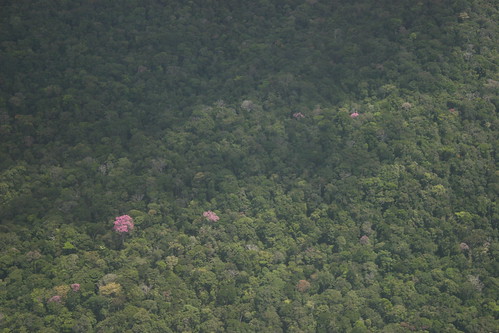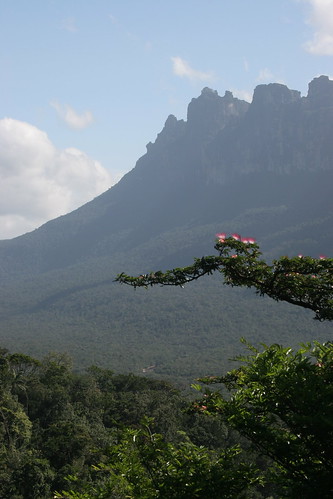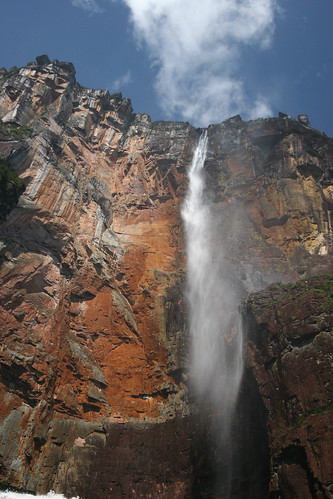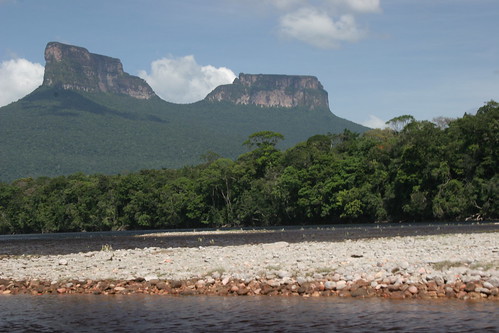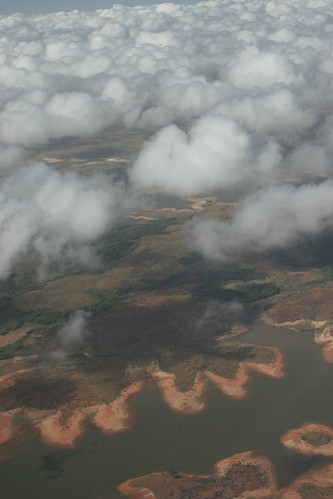Sunday, March 11, 2007
Tepuys, Canaima National Park, Venezuela
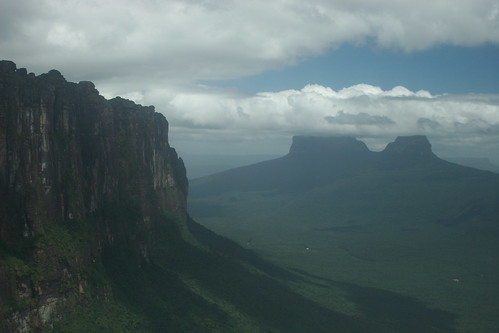
It's a two-hour flight from Canaima to Santa Elena in La Gran Sabana. On the way we fly two circuits around Angel Falls but there's no sense of scale from this height and therefore does not compare to the experience of seeing the falls at close proximity. I'm now even more grateful at having had the opportunity to go upriver.
Canaima National Park, Venezuela
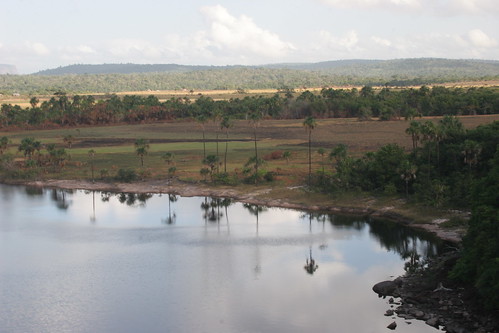
I'm still reeling from the trip to Angel Falls yesterday so the trip across Lake Canaima to Isla de Anatoliy and Sapo Falls nowhere near compares. As it's the dry season the falls have almost dried up but there's a powerful cascade in the middle and a slippery path underneath. There are also beautiful views of Canaima National Park across the lake.
Angel Falls, Venezuela
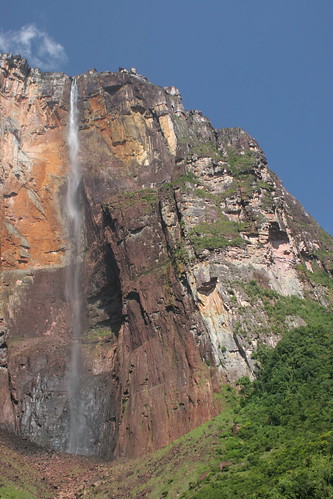
Angel Falls was accidentally discovered by American pilot Jimmie Angel who landed on the top of the tepuy in 1937 in his light airplane in search of gold. His plane got stuck in the marshes and couldn't take off again so he was forced to trek through the rough terrain and descend a kilometre of almost vertical cliff. It took him 11 days to reach civilisation.
After nearly two hours of fairly strenuous walking I reach the lookout point. Although the cascade from the top of Auyún tepuy is elegantly slim, it's still breathtaking as it tumbles nearly 1km into the pool beneath known as the Cañon del Diablo (Devil's Canyon). Angel Falls is the world's greatest uninterrupted drop, 16 times the height of Niagara Falls. I lie on a rock staring upwards. I could stay here watching for hours but unfortunately we need to hike back and start our long journey back down the river.
The fact that Angel Falls is so remote and not easy to reach (a minimum of six hours by canoe plus a two hour hike) makes it that little bit magical.
Anaconda, Angel Falls

A short time into our walk one of our group spots a young anaconda of about 1.5 metres coiled under a bush. We all freeze as it slowly crosses the path in front of us. It's only the second time I've seen a snake in the wild and although I'm assured it's a rare occurence, for the next half hour I nervously scrutinise the tree roots on my path.
Jungle walk to Angel Falls
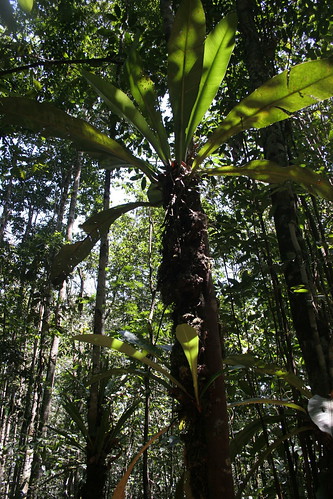
I do not sleep well. The hammocks are strung too close together and somehow I manage to be repeatedly elbowed in the head during the night.
The two-hour hike from camp to Angel Falls climbs through steep dense rainforest. The forest floor is covered with rocks and a thick network of winding tree roots which are tricky to negotiate. Although it's so humid I have sweat pouring off my chin within minutes, I'm enjoying the hike. The sunlight filters through the tree canopy lighting up the pretty bromeliads high in the trees.
Angel Falls camp, Canaima, Venezuela
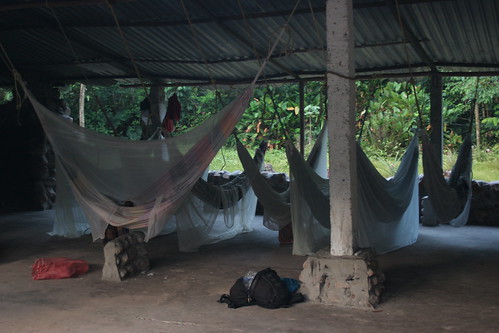
Six hours after we began our adventure up the river someone points out a thin white wisp of water spilling out from the top of Auyún tepuy. We all know it's Angel Falls but it's rather underwhelming. Even our guide is disappointed having only seen it in its voluminous wet months. Nevertheless I'm not disappointed as I've already reached sensory overload with the stunning landscapes I've seen today. Tomorrow we'll hike up through the jungle to the base and have a closer look.
Our camp for the night at Isla de Ratón is basic to say the least - a concrete shelter with a couple of wooden beams to attach our hammocks to. As we're all exhausted we manage a quick dinner before collapsing in our hammocks at 9pm.
Journey to Angel Falls, Venezuela
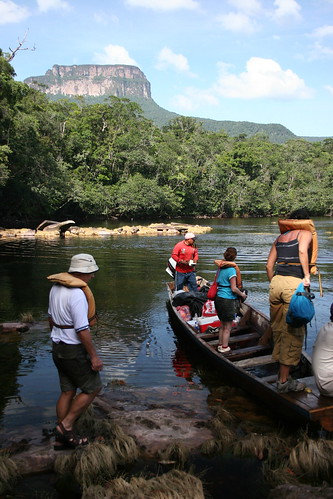
Soon we're travelling up the Churún, a smaller shallower tea-coloured river lined with pink stones. The colour of the water comes from the tannin in the plants that seeps into the river. The views of the tepuys around are breathtaking and I feel I'm in a surreal prehistoric world. I don't want this magical journey to end.
The canoe skims over the river bed jerkily crashing from side to side. Occasionally we become beached on the rocks and the boys climb over board and push until we're free again.
Three hours in and the wooden seats have numbed my behind. I'm sunburnt and wet but still in awe of the amazing landscape.
Journey to Angel Falls, Venezuela
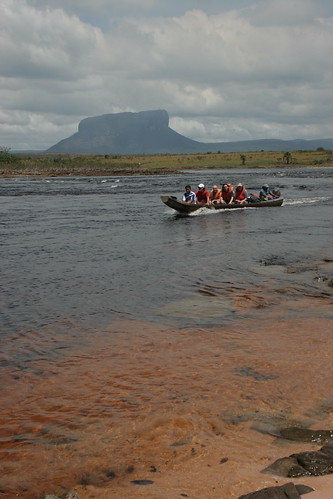
On arriving at camp we're given the surprising news that we will be able to take canoes up to the base of the falls but we're likely to need to get out and push at times as the river is so low. No one cares; we're just thrilled to be able to do it. And we need to leave immediately in order to arrive before dark.
We manage to fit into two wooden motorised dug-out canoes and start out journey up the fast-flowing Karrao river. The river is wide, shallow and full of jagged rocks. As we pass through several rapids most of us manage to receive a good soaking which is not unpleasant in the sticky heat. An hour in and I glimpse the huge labyrinthine Auyún Tepuy rising majestically from the pristine rainforest. Angel Falls tumbles from its summit but we'll have to travel up-river for another five hours until we can get our first glimpse.
Tepuy, Canaima National Park, Venezuela
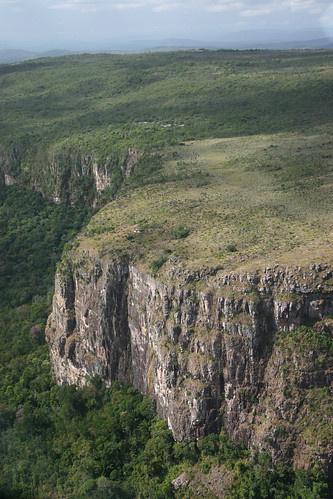
Flying over Canaima National Park, I have my first glimpse of tepuys or tepuis, giant flat-topped sandstone mountains rising out of the jungle dating back two billion years. 'Tepuy' is the local Pemón people's word for mountain. Sir Arthur Conan Doyle based 'The Lost World' on these structures after reading an article on the discovery of unique ecosystems that have managed to evolve independently on the summit of these monoliths. Each tepuy has developed its own characteristic plant life and consequently the area has the highest percentage of endemic flora to be found anywhere in the world.
Flying to Canaima, Venezuela

Having felt generally unimpressed by anything over the past couple of weeks, I'm finally excited again about travelling to Angel Falls which is a minimum six-hour boat trip into the heart of Canaima National Park. Unfortunately as it's the dry season, the river is low so it's looking unlikely that we'll be able to take the canoes to the base of the falls. We're told the best we can hope for is a flight over the top, which is a little disappointing for everyone.
The flight to Canaima takes 1.5 hours in a rickety light aircraft. We pass over dense broccoli-like rainforest and land at Canaima camp at midday.
(Photo - taken by Bob (on the left))
Sunset at Ciudad Bolívar, Venezuela
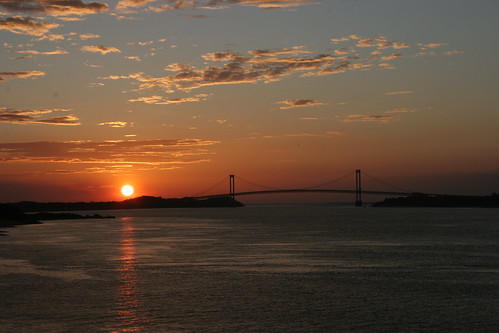
Last night I had my most expensive meal so far in South America at GBP 17. It's a shock after paying on average GBP 3 for a meal. Venezuela appears to be even more expensive than Chile.
I'm not sad to be leaving Caracas today. Although I didn't hear them myself my travelling companions were excitedly talking about the gunshots they heard close to our hotel.
It's a 9-hour bus ride to Ciudad Bolívar, the place Simon Bolívar set up his base to liberate most of South America from Spanish rule. Ciudad Bolívar is a colonial city on the banks of the Orinoco. It's old name is 'Angostura' which means 'the Narrows' as here the river is at its narrowest, at only 300 metres wide. We arrive just in time for sunset and I'm doubly pleased as I've now finished Anna Karenina.
Caracas, Venezuela
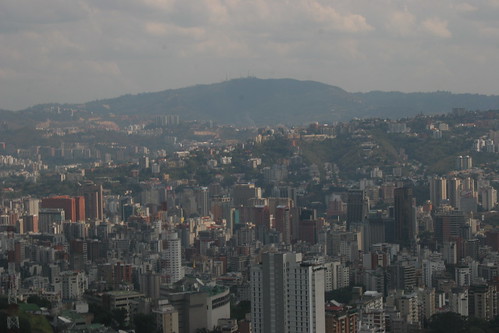
I'm on a roll so decide I might as well do the one other thing I wanted to do in Caracas which is to take the teleférico (cable car) up to Mount Ávila for a view of the city. Still paranoid about being mugged/shot I take a taxi to the bottom of the hill.
As I've been used to paying so little for everything in South America the ticket price seems a little steep at 30 Bolivars (about GBP 7). I seem to be the only person around so I have a car to myself which is just as well as my camera spookily decides to play up, just as it did on the cable car up to San Cristóbal in Santiago. The 20-minute ride up passes over two large hills which gives me enough time to panic, administer emergency surgery on my camera and calm down as I unbelievably manage to fix the problem.
From the top of Mount Ávila there is a hazy view of Caracas on one side and a view of green hills leading down to the sea on the other. Unfortunately like the cable car in Quito, they've made it into a mini amusement park complete with ice rink, 3D simulator and children's playground.
(Photo - Caracas from the cable car)
Botanical Gardens, Caracas, Venezuela
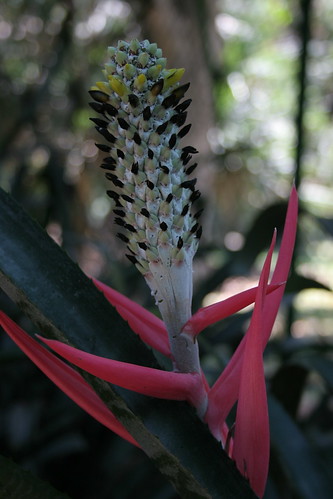
I have a full day in Caracas before I head out east so decide to visit the Botanical Gardens as recommended by my guidebook. I'm not disappointed as they're some of the most well-maintained gardens I've seen, with a wide range of Bromeliads and unusual trees. I manage to spend a couple of hours leisurely walking around but this may have something to do with the 30 degree heat.
Going to Caracas
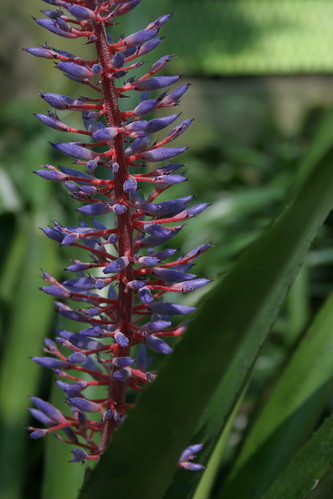
On my early morning ride to the airport I watch the the mist drifting in from the mountains and casting a warm glow over the city. It makes me a little sad to be leaving Quito as I've enjoyed the past few days here. I'm also slightly nervous about going to Caracas and wondering if I'm going to have to stay holed up in my hotel room the entire time, or if the danger aspect is exaggerated.
I've never heard of Santa Barbara Airlines and am wondering if it's the cowboy airline of Venezuela. At check-in I overhear a guard telling the people in front that they can't take water, cream or liquids in their hand luggage. I have all of these things in my bag so I ask him if it applies to sunscreen. He asks me where I'm going. When I answer 'Caracas' he laughs and says 'Oh, they don't care about that there'. I'm not sure if this is a good thing or not.
I'm completely paranoid when I arrive in Caracas airport and break into a slight run (very difficult with my backpack) every time someone approaches me for money exchange or taxis. As I have no local currency (bolivars) I head to the bank and try to take some money out of the cash machine. It says 'thank you very much - please take your money' but hasn't dispensed any. Stupidly I try the transaction again thinking I perhaps didn't read the instructions properly but it does the same thing. Inside the bank they assure me it won't be debited from my account. Lonely Planet says differently! LP also says that a taxi to the city centre should cost around USD 15 so I almost have a heart attack when I'm quoted 70. Not liking Caracas much so far. Have been warned about taking an unofficial taxi, of which there are lots, so I bite the bullet and after much negotiation agree to pay USD 40 to my hotel in Sabana Grande.
On the way into town I pass by a sprawling shanty town and remember that Caracas has the unfortunate honour of having one of the largest slums in the world, or so I've been told. It's also the fastest growing capital in Latin America having grown from 350,000 people to nearly five million in the last 50 years.
Not sure what I expected but Caracas is hillier and greener than I had envisaged. It's also modern, fast-paced and hot. Skyscrapers mixed in with a hotchpotch of randomly-shaped buildings dominate the skyline. It's messy, not pretty and feels like a shabbier version of Rio. Despite oil money being pumped into modernising the city, the disparity between rich and poor is evident, as in many of the countries in South America.
(Photo - Botanical Gardens, Caracas)
Subscribe to:
Comments (Atom)
